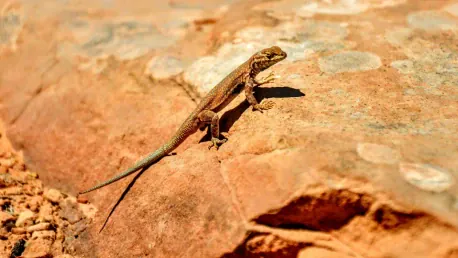The dunes sagebrush lizard, a small reptile dwelling in the sandy regions of West Texas and southeastern New Mexico, has found itself at the center of a fierce political and legal battle. The debate over its protection status encapsulates broader tensions between environmental protection efforts and economic interests, specifically those tied to the oil and gas industries. Sparked during Barack Obama’s presidency and reignited under President Joe Biden’s administration, the controversy has not only involved federal and state government agencies but has also engaged the Office of the Attorney General in Texas, highlighting the deep-rooted conflict.
Historical Background
Origins of the Controversy
The listing of the dunes sagebrush lizard as an endangered species dates back to the Obama administration. Initially driven by concerns over habitat loss due to oil and gas extraction, the federal proposal faced immediate backlash from Texas officials who argued that the move was economically motivated rather than environmentally necessary. This early stage set the tone for the prolonged conflict that would continue across multiple Democratic administrations. Early on, the debate centered on the balance between conserving the lizard’s fragile habitat and fostering economic growth in one of Texas’s most critical industries. As oil and gas operations expanded within the lizard’s habitat, conservationists warned of irreparable damage to the species, while industry advocates decried the potential for job losses and economic downturns.
The Obama administration’s stance was firmly rooted in the scientific findings that pointed to a significant decline in the lizard’s population and habitat quality. This prompted federal agencies to push for protective measures that they believed were necessary for the species’ survival. However, this move was met with stiff opposition from Texas legislators and industry leaders who saw the listing as an unnecessary federal overreach into state affairs. This clash not only showcased the polarization of environmental versus economic priorities but also set the stage for an ongoing legal and political skirmish that has persisted for over a decade.
Ongoing Federal Efforts
Throughout subsequent Democratic presidencies, efforts to maintain or reinstate the dunes sagebrush lizard’s protected status have persisted. These initiatives are often portrayed by the state of Texas as strategic moves aimed at curtailing the state’s economic growth, specifically targeting its robust oil and gas sector. The consistent federal push underscores the priority placed on environmental conservation, despite significant opposition at the state level. The Biden administration’s renewed commitment to climate change and environmental protections has only reignited this long-standing controversy, prompting new rounds of debates and legal battles.
The federal government argues that protecting the dunes sagebrush lizard aligns with broader environmental goals, including preserving biodiversity and mitigating the impacts of climate change. They contend that without stringent protections, the lizard’s habitat would continue to deteriorate, leading to the species’ eventual extinction. On the other hand, Texas officials and industry stakeholders argue that the economic costs of such protections are too high, impacting land use and limiting the state’s ability to exploit its natural resources. This tug-of-war between federal priorities and state interests continues to shape the discourse surrounding the dunes sagebrush lizard and highlights the deeply entrenched divisions on the issue of environmental regulation.
Legal Challenges and Court Rulings
Texas’s Legal Actions
Texas, led by Attorney General Ken Paxton, has repeatedly challenged the federal listing of the dunes sagebrush lizard through various lawsuits. These legal actions contest the validity and motivations behind the endangered species designation, arguing that such listings represent federal overreach and threaten economic stability. The state’s litigation strategy reflects a broader resistance to federal environmental regulation perceived as economically harmful. Paxton and other Texas leaders contend that the lizard’s listing is part of a broader agenda to undermine the state’s economic autonomy and regulatory freedom.
The legal battles initiated by Texas often focus on procedural and substantive aspects of the federal listing process. Texas has questioned the scientific data used to justify the lizard’s endangered status, arguing that uncertainties in the data do not warrant such stringent protections. By framing the issue as one of economic survival versus ecological precaution, Texas aims to sway public opinion and garner support for its position. This legal strategy has led to a series of high-profile court cases that draw attention to the broader implications of federal environmental regulations on states’ economic ambitions, particularly those rich in natural resources.
Key Court Decisions
The courts have played a crucial role in this ongoing battle. Various rulings either supporting or overturning federal decisions to list the lizard have significant implications not just for the species itself but also for the power dynamics between state and federal authorities. These judicial outcomes are closely watched by stakeholders on both sides, as they set important precedents for future environmental and economic policies. In some instances, courts have sided with the federal government, validating the scientific basis for the lizard’s listing and upholding the necessity of protective measures. In other cases, rulings have favored Texas, highlighting deficiencies in the federal process or deeming the economic costs unjustifiable.
Each court decision contributes to the evolving legal landscape surrounding endangered species protections. When courts rule in favor of federal protections, it reinforces the legitimacy of scientific conservation efforts, potentially emboldening other states to implement similar measures. Conversely, decisions supporting Texas’s position can prompt a reevaluation of federal strategies and lead to adjustments in how endangered species listings are approached. These judicial rulings also influence ongoing policy discussions at both the state and federal levels, affecting future legislative actions and regulatory frameworks related to environmental conservation and economic development.
Economic Implications for Texas
Impact on Oil and Gas Industry
The heart of Texas’s argument against the federal protection of the dunes sagebrush lizard lies in the economic impact on its oil and gas industry. This sector is a vital component of the state’s economy, providing substantial revenue and employment. Texas officials assert that the endangered species listing restricts land use and development, thereby hindering industry growth and economic prosperity. Oil and gas companies operating in the region argue that the listing imposes costly compliance requirements and limits access to valuable resources, leading to a decline in production and investment. This, in turn, could result in job losses and decreased state revenue, impacting local communities reliant on the industry.
Texas’s economy is heavily intertwined with its energy sector, making any perceived threat to this industry a significant concern for state leaders. The argument posited by Texas officials is that the federal government fails to account for the broader economic consequences of the lizard’s listing. They argue that a balance must be struck between environmental protection and economic viability, emphasizing that responsible industry practices can coexist with conservation efforts. This perspective underscores the importance of the oil and gas industry to Texas’s financial health and regional stability, framing the federal listing as an attack on the state’s economic interests.
Broader Economic Considerations
Beyond the oil and gas industry, the potential restrictions associated with the lizard’s protection might affect related sectors and local communities. Concerns about job losses and reduced state revenue are central to Texas’s opposition, framing the federal actions as economically detrimental not only to industry players but also to the broader population reliant on these economic activities. The ripple effects of industry contraction could affect local businesses, services, and public infrastructure, creating a domino effect that extends well beyond the immediate scope of the endangered species listing.
The economic narrative presented by Texas highlights the perceived trade-offs between environmental regulations and economic stability. State officials argue that excessive regulatory burdens could stifle innovation, discourage investment, and erode the competitive edge that Texas enjoys in the energy market. This broader economic concern is often cited in legal and political debates, painting the lizard’s protection as a symbolic representation of federal policies that disregard local economic realities. The tension between these competing priorities—environmental sustainability and economic growth—serves as a focal point for the ongoing conflict and shapes the discourse surrounding the dunes sagebrush lizard’s endangered status.
Environmental and Conservation Perspectives
Federal Conservation Goals
From the federal perspective, the protection of the dunes sagebrush lizard is seen as a crucial part of broader environmental conservation goals. Federal agencies argue that maintaining biodiversity and protecting endangered species are essential duties, imperative for the ecological health of the region. The lizard’s habitat, they assert, is a unique ecosystem that warrants rigorous protection efforts. By safeguarding the dunes sagebrush lizard, federal authorities aim to preserve not only the species but also the broader environmental integrity of the area, which supports numerous other flora and fauna.
Federal conservation strategies are often built on the premise that all species play a critical role in their ecosystems, contributing to overall biodiversity and ecological balance. Protecting the dunes sagebrush lizard, therefore, is positioned within a larger framework of environmental stewardship that prioritizes the preservation of natural habitats over immediate economic gains. This long-term view emphasizes the need to address habitat degradation and other threats to biodiversity systematically, reinforcing the federal commitment to environmental conservation as a foundational principle of public policy.
Scientific Justifications
Federal authorities and environmental groups often cite scientific studies to justify the endangered status of the dunes sagebrush lizard. Research indicating habitat degradation and population decline underpins their argument, suggesting that without intervention, the species faces a significant risk of extinction. These scientific narratives shape federal policies and reinforce the necessity of conservation actions. Studies have documented the lizard’s shrinking habitat, mainly due to oil and gas activities, and have highlighted the species’ vulnerabilities to environmental changes, further substantiating the call for protective measures.
The scientific community supports the federal stance by providing data-driven evidence of the ecological importance of the dunes sagebrush lizard and the imminent threats it faces. Conservation biologists emphasize that protecting the lizard requires comprehensive habitat management strategies that account for the species’ specific needs and the broader environmental context. This scientific underpinning is crucial for legitimizing federal actions and countering claims that the listing is politically or economically motivated. By focusing on empirical evidence and ecological principles, federal agencies aim to build a strong case for the necessity of the lizard’s endangered status.
State-Federal Relations
Autonomy vs. Regulation
The dispute over the dunes sagebrush lizard’s protection is emblematic of broader tensions between state autonomy and federal regulation. Texas’s resistance highlights the desire for states to control their economic and environmental policies without what they perceive as unwarranted federal interference. This tension reflects wider national debates about the balance of power in the American federal system. State officials argue that they are better positioned to understand and manage their unique economic and environmental contexts, advocating for a decentralized approach to policy-making that respects state sovereignty.
The autonomy-versus-regulation debate often centers on the principle of states’ rights, with Texas leaders asserting that federal environmental regulations encroach upon their ability to govern effectively. This conflict is not limited to the dunes sagebrush lizard case but extends to various other policy domains where state and federal interests collide. The crux of the argument is the perceived overreach of federal authority into areas traditionally managed by states, prompting calls for greater respect for state autonomy in setting economic and environmental priorities.
Political Implications
The dunes sagebrush lizard, a small reptile native to the sandy regions of West Texas and southeastern New Mexico, has become a central figure in an intense political and legal conflict. This debate over its protection highlights the ongoing struggle between efforts to safeguard the environment and economic interests tied to the lucrative oil and gas industries. The conflict originally emerged during Barack Obama’s presidency and has been revived under President Joe Biden’s administration. The dispute has drawn in federal and state government agencies, and notably, the Office of the Attorney General in Texas has taken an active role. This highlights the deep-seated tensions between environmentalists advocating for the lizard’s protection and economic stakeholders worried about the impact on their industries. The controversy over the dunes sagebrush lizard is thus a microcosm of the broader, ongoing conflict between the need for environmental regulations and the pressures of economic development.









